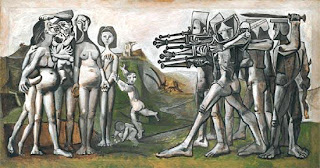The painting I have chosen is The third of May 1808 by Francisco de Goya. It is also known as The shooting of the mountain of Príncipe Pío. It was painted in 1814 and commissioned by the Regency, when Ferdinand VII hadn’t still come back from France. The technique that Goya used is oil on canvas and the dimensions of the painting are 266 × 345 cm. This painting is the culmination of another painting: The Charge of the Mamelukes. This painting has always been in El Prado Museum in Madrid except for the period when the republicans made an evacuation of all the paintings of El Prado Museum during the Civil War. The painting is the room 64 of the Prado Museum.
This painting shows the consequences that the 2nd of May 1808 had, when the people attacked the French troops that occupied the city of Madrid. At first sight we can see many people who have been killed, other people who are going to be killed and other people who are the soldiers. We can see fear faces and also we can see provocative faces. In the background we can see a palace or a castle.
The composition of this painting is divided into two different parts: the first one to the left, that is composed by a group of citizens who have different postures and these postures determine the attitudes these people have towards death. And on the right side there are the soldiers who are shooting the citizens. Goya represented this painting with darker colours and with brown and ochre tones. We can also see some white colours, like the white shirt of the man who has the arms in a cross position and the lamp that is near the soldiers. This painting doesn’t have much light in order to show a sinister atmosphere. We can see that the light is artificial, provided by the lamp the soldiers have. This light doesn’t illuminate the soldiers and the Spanish citizens in the same way. On this painting Goya didn’t use straight lines, because he wanted to be expressive and used dissolute brush-strokes. The landscape in the foreground is indefinite.
The truck in which this painting travelled during the evacuation had an accident and suffered some damage and was restored in Gerona by Tomás Pérez y Manuel Arpe y Retamino.
https://commons.wikimedia.org/wiki/File:El_tres_de_mayo_de_1808_(detalle).jpg
Francisco de Goya is considered to be the precursor of many styles, such as romanticism, realism or impressionism, but this painting is considered to be a historical painting because it represents a historical moment of the history of Spain. I have read some information which says that Goya accepted to paint this because of his situation as Francophile. Also if we watch this painting, we can say it belongs to Romanticism due to the colours and style.
Goya’s painting was the inspiration for some paintings:
Édouard Manet copied the structure of Goya’s painting in his work Emperor Maximilian's shooting in 1867, but he used lighter colours. Picasso also made a painting inspired on Goya’s painting, called Massacre in Korea in 1951 but in a completely different style. He painted this because he wanted to criticized the power of the West in a wanted dehumanization.
I like this painting, because Goya reflected it without keeping any part empty. He represented the scene with all the details, as if he was a photographer. I also like this painting because it is very good, all the characters have a different and expressionist faces and painting this has a lot of difficulties. I like most of Goya’s paintings because all are different.
I like also the Playmobil and I have found this, which is very nice.
Sources:
https://www.youtube.com/watch?v=TylGuoEN5x4
http://es.wikipedia.org/wiki/Fusilamientos_del_tres_de_mayo
http://www.biografiasyvidas.com/monografia/goya/cuadros22.htm
http://www.homines.com/arte/fusilamientos_3_mayo_1808_goya/index.htm

.jpg)



1 comment:
Hello,
I've corrected some mistakes directly. You've forgotten to include the sources of the last pictures. Your mark is 9. See you!
Post a Comment